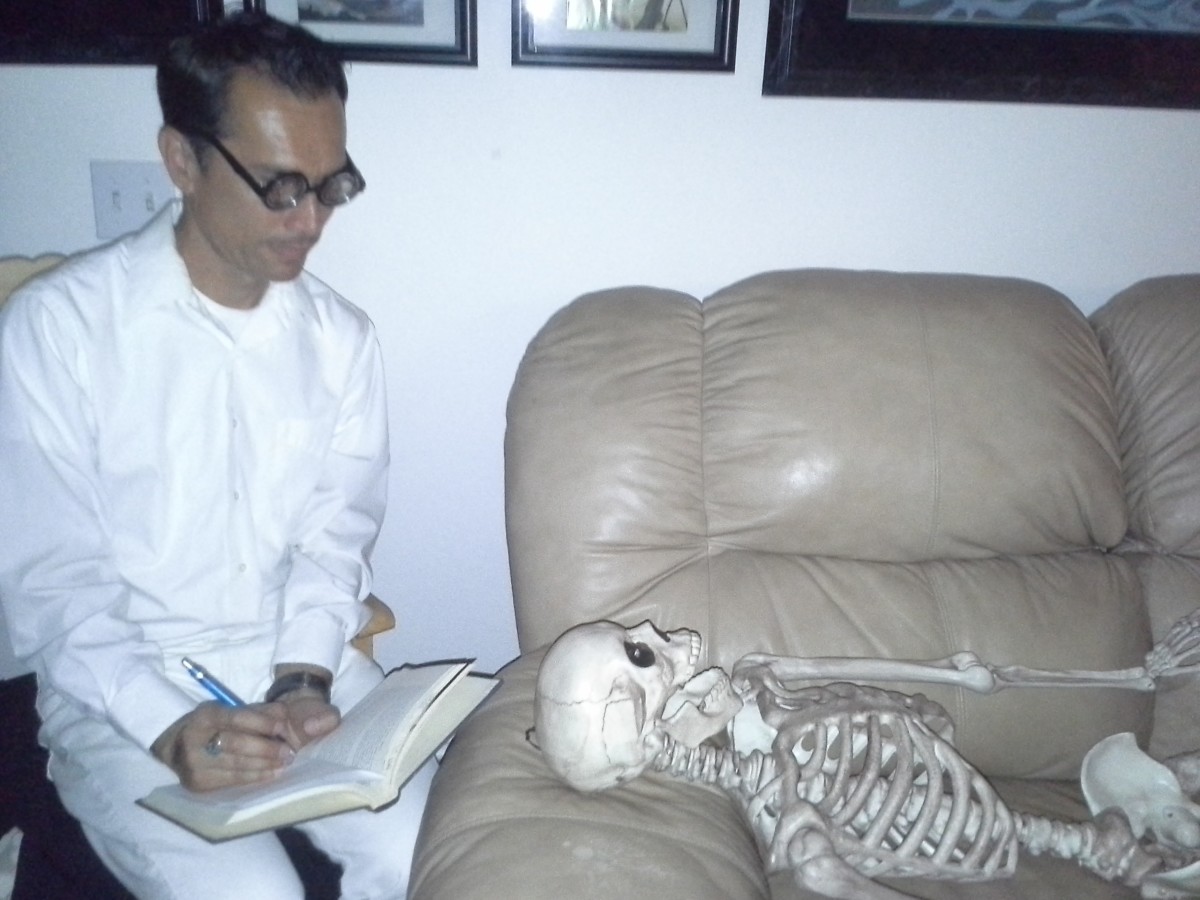The Gigantic 12 Storey Bicycle

From a forthcoming book, "Oak", the fourth in the Threat-Hamster series
In the north of England, where historically the Green And Pleasant Land has tried to avoid that stereotype, there lived, as there so often does, a person called Fred. He was a lemon of a man, with a face that indicated that no thought had ever trespassed between his ears.
Fred was part of the great social ballast which has prevented the north of England rivaling Paris. He was a preserver of the mundane, a defender of the trivial, and a saint of the inconsequential.
People would stop talking about nuclear physics and spiritual enlightenment in his presence. The vast banal universe which he represented refused to allow conversation to arise to “mental” topics, as Fred so laboriously described them.
Fred’s almost equally below-the-water-table friends were of a similar type, but not so dramatic. As you might expect, these were the councilors and merchants of the little town Fred condescended to inhabit, Sad Puddlebury. A five second conversation with any of these solid objects would convince anyone that nouns were terribly frivolous, unkind things.
These people, however, weren’t in Fred’s class. All he had to do was enter a pub and the talk about the war would revert to a more proper discussion of bunions. People would deliberately miss with darts, so as not to attract unfavorable comment about “those above their station” from Fred’s mighty repertoire of social justice observations.
Which was why it was somewhat of a surprise when Fred entered the pub one day with an expression on his face bordering on consciousness, and said.
“We need a gigantic 12 storey bicycle”.
That, naturally, was that. There would be a gigantic 12 storey bicycle, no question about it. His friends nodded.
Fred usually never explained anything he said, so the whole idea became much more interesting when he added,
“Met a bloke. Said he could build a gigantic 12 storey bicycle if we needed one.”
The next council meeting was devoted to planning the gigantic 12 storey bicycle. As it happened, Fred had no idea what a gigantic 12 storey bicycle looked like, but the “bloke” did, so he was hauled along to the meeting. This was the first outsider in 40 years ever to attend a council meeting, so the locals were pretty sure something big was afoot.
He brought with him a plan for the bicycle. Assembling it was easy enough, apparently. It was the fabrication that was tricky. They’d need to make each part locally, and assemble it piece by piece. That would require a large building, said The Bloke.
The only really large building was the local high school, so that was shut down immediately. As Fred commented, it was no use to teach kids things they’d only forget, anyway.
The frame, naturally, was the first thing to be constructed. Cars were melted down in the new foundry and within a few years of trial and error a gleaming new frame was made. This was a boy’s bike, according to The Bloke, so it was painted blue. A local paint merchant, who’d bought 20,000 litres of pink paint, ran away at this time and was eaten by a railway station.
Making the wheels was somewhat more difficult. Several blocks had to be demolished for a marquee of sufficient size to be used to cover the wheel construction and to allow space to move the wheels to the frame. Rubber for the tyres was obtained by melting down car tyres.
This was a time of Renaissance in Sad Puddlebury. Sparkling conversation about the gigantic 12 storey bicycle was on everyone’s lips. Some newborns were even given middle names of Gigantic 12 Storey Bicycle to mark the event.
The wheels were a slight problem. The spokes required huge amounts of steel and fabrication. Then, apparently, they had to be fitted to the centres of the wheels, and those hadn’t been made yet.
Hundreds of spokes were guarded around the clock by the populace against rust and theft. As Fred said, “Can’t be too careful. Might lose one.” Stern eyed villagers, doctors and teachers made sure this never happened.
The handlebars, which were massive, required the demolition of the council chambers and a local hospital. To raise them, a crane was required, which involved stealing all the cars from neighboring villages. (Actually, because it was Fred’s project, nobody minded, but it looked so nice to see people from Sad Puddlebury scuttling about in the middle of the night swiping cars.)
A small university was converted into a crane as well. The students and faculty were greatly reassured by Fred’s remark that they’d now have more time to spend at the pub, “instead of all that nonsense”, as Fred put it.
Came the great day when the parts were all ready to be assembled. The mighty frame was raised. The village of Sad Puddlebury was converted into scaffolding, to allow easy access for painters and decorators. The handlebars, after some erudite cursing, were fixed. They’d been the wrong size, so they’d had to be rebuilt, and the neighboring village of Glum Thudding razed to the ground.
The wheels were placed, and the spokes carefully added. The bike, although not yet complete, looked magnificent.
The scaffolding was removed, to cheers.
The bike fell over.
“We need a bike stand,” stated Fred, authoritatively.
“And a bell,” said The Bloke.
“And a bell,” said Fred.
Some consternation was expressed when it was discovered that the bike would require training wheels in secret council meetings held in a tree the following year. Four training wheels, to be precise, because the front wheel wasn’t stable.
The people of Sad Puddlebury emerged from their burrows two years later to see their gigantic 12 storey bicycle standing proudly gleaming in the sun. Their badger-like existences took on new meaning.
Fred, resplendent in his overalls, made a moving speech:
“Declare this gigantic 12 storey bicycle open.”
There was rejoicing and much consumption of fodder at the one remaining building in 40 miles, the local pub. Briar wine, which had replaced beer, and in some cases water, was consumed lustily.
The Bloke, well in his cups, had a thought, which he whispered to Fred:
“We’ll need pedals.”
Pedals were constructed by digging up the graves and using the skeletons as frames, the region having run out of steel in the previous decade.
Fred now had a thought, his first.
“What about a seat?” he asked The Bloke.
“Ah, no, that’s where we put the control mechanisms. As people pedal, they’ll need special machinery to connect to the drive chain.”
“Oh,” said Fred.
A four storey building, full of chains, gears, and places for peddlers to sit, was placed where a seat would be on a bike. The peddlers were grouped in rows, each driving a special chain connected to the bike chain. There was space for 200 people.
“We should probably make the bike chain,” commented The Bloke the following Spring.
“Ah,” said Fred.
Eventually, having run out of omissions from the bike’s design, the first test drive began. At a princely 2 millimeters an hour, the great vehicle took to the roads, which promptly fell to pieces.
Across the ravaged landscape, like some vision of tomorrow, went The Gigantic 12 Storey Bicycle, occasionally reaching speeds of 2cm an hour as the emaciated but enthusiastic inhabitants of Sad Puddlebury learned how to use the pedals properly.
There were some problems. The people of Sad Puddlebury hadn’t been inside a building for so long they’d forgotten how to use one. They kept trying to burrow into the nearest thing handy, usually another person, when asleep. The concept of “plumbing” had escaped them entirely, and they kept having to stop to bail out and get more sawdust and kitty litter for the floor.
The Gigantic 12 Storey Bicycle majestically traversed Britain. Crowds emerged from their burrows to see the fabulous machine glide serenely by. Other British towns decided to follow Sad Puddlebury’s example and began to construct all manner of vehicles.
The Great Skate Of Bristol was one of the more memorable efforts. Although it never moved a nanometer, it created employment for 104 years. The Giant Trousers of Manchester, using turbo prop engines and providing habitation for 124,000 people and 75,000 dogs, were the peak of this engineering form.
(The North Sea responded quite well to counseling after its encounter with The Giant Trousers, so let’s not go into that…)
And so it was that Britain disappeared in a haze of well meaning machinery. The British pound was replaced by a pitiful smile. The City of London caught a plane to Dusseldorf, leaving the inhabitants behind. Cornwall rowed itself to Ireland, leaving the natives clinging to pasties and mostly empty bottles of Scrumpy in the Channel. The Royal Navy took it upon itself to forge a fleet of monster skateboards, and depopulated most of the east coast of Britain and the west coast of Europe.
The Bloke, who’d been thinking hard, had a revelation.
“What if we just put wheels on the whole island…?”
“Yes,” said Fred.



